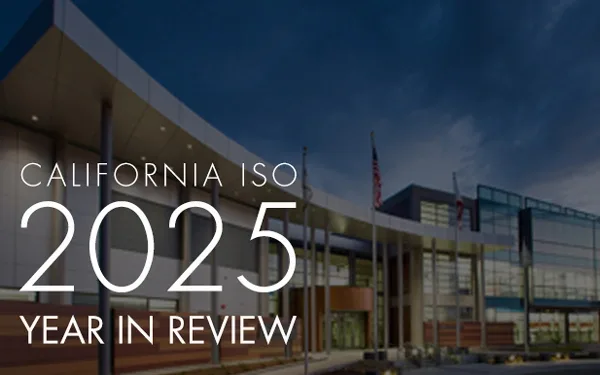Preparing for winter takes on greater importance


While preparing for winter doesn’t usually bring the same stress as getting ready for summer in California and the rest of the West, it has become an increasingly important planning exercise for the ISO. As one key activity, the ISO and our team at RC West, which is the Reliability Coordinator of record for 25 balancing authorities and 40 transmission operators in the region, hosted a public winter readiness session last week for about 140 attendees from around the West.
We started with a brief review of this summer which passed without any major grid reliability issues. We then shared information about the upcoming forecasts for winter weather and fires, including the outlook for precipitation, water levels across the West, the status of natural gas supplies, details about planned outages and construction that could affect transmission capacity, and much more.
We also heard from energy providers across the West who spoke about their company’s preparations to ensure reliability during the winter months ahead. It was a highly productive day, reflecting how making sure we are adequately prepared for winter has grown into a critical part of our reliability planning that once only focused mainly on summer.
After the session, Brian Murrary, the ISO’s director of Balancing Authority Operations, shared the following observations about the topics that were discussed.
The extended weather forecast came first:
- Trending towards a relatively weak La Niña, similar to last winter.
- Likelihood for near normal temperatures for the Northern regions, with normal to above normal precipitation.
- The Southern regions have elevated chances to see above normal temperatures and below normal precipitation.
- There is always the chance for short-term extreme weather events.
- Seasonally normal Santa Ana winds in Southern California will create fire risk similar to last winter, when Southern California experienced a number of devastating wildfires.
A representative from CAL FIRE noted that its weather forecasts align with the ISO’s and that the fire fuel risk in Southern California is expected to be high with persistent drought conditions.
Lessons Learned from last Winter
Last winter was a reminder that fire season across the Western U.S. is no longer limited to the summer months with the devastating Eaton and Palisades fires in Southern California occurring in January 2025. While these events caused local reliability concerns, they served as an important reminder to build flexibility into our seasonal planning and preparedness efforts.
From an extreme weather standpoint, aside from those Southern California fire events, the ISO Balancing Authority was not significantly affected by major events within our footprint. However, we did play an important role in helping to support Pacific Northwest entities during their Arctic blast and cold weather events. This required close coordination on Western Energy Imbalance Market transfers and RC West management of scheduled and unplanned outages, particularly those that impacted South-to-North flows on the California-Oregon Intertie.
The ISO Extreme Weather Playbook
Looking ahead, we’ve expanded our operational readiness through the Extreme Weather Playbook – a guide that helps us prepare for severe conditions and aligns with new requirements set last year by NERC, the North American Electric Reliability Corporation. A key enhancement is how we forecast our short-term energy needs. In the past, we provided day-ahead forecasts that extended out over eight days but only flagged issues that could arise during peak demand hours. Now, our forecasts provide a full picture of every hour in the day, for eight days.
In addition, plans for concerning circumstances – including regional gas issues – have been broadened to capture region-wide extreme events, giving us earlier situational awareness to better coordinate. Once an extreme weather trigger is identified, ISO Operations teams will coordinate, document, track, and log the event from initial forecast through operational actions. These processes strengthen our situational awareness, making our action more transparent, consistent and repeatable across the organization.
New Generation and Transmission Readiness
A significant amount of new capacity is scheduled to achieve commercial operation across the California ISO Balancing Authority in the coming months. From September 1, 2025 through April 2026, we expect to add 4,343 megawatts (MW) of new resources, with 2,406 MW of those being battery storage. The additional batteries continue to reflect the critical role these assets have in supporting evening net peak periods, providing flexibility, and enhancing system reliability during extreme weather events.
These additional resources come on top of the ISO having onboarded more than 26,000 MW of new generation capacity since 2020, including approximately 7,000 MW last year alone. The grid is undeniably more resilient and stronger than it was just a few years ago.
We look forward to bringing on the new SunZia transmission line later this year. It includes a 551-mile, ±525kV HVDC and 345kV HVAC transmission system connecting to a 3,600 MW wind project in New Mexico. Over the coming months, we will be engaged in testing and commissioning activities to ensure that this major resource is integrated reliably and securely into the Western grid.
Gas and Electric Systems Coordination
ISO Operations teams have continued to strengthen coordination of gas and electric system operations across the Western U.S. and Canada. Joint meetings to discuss seasonal outlooks and impromptu meetings based on system or weather conditions have become a part of our normal operations. This increased awareness and coordination helps both energy systems maintain the highest reliability during stressed conditions.
In summary, members of the ISO’s Operations teams are continuously adapting to meet the demands of a changing energy landscape. With year-round fire risk, extreme weather events, gas system conditions, and the integration of new resources, our approach to reliability must be more flexible than ever. Lessons learned from last winter, combined with the ongoing operational enhancements, position us to provide greater reliability and support across the West this coming winter.


